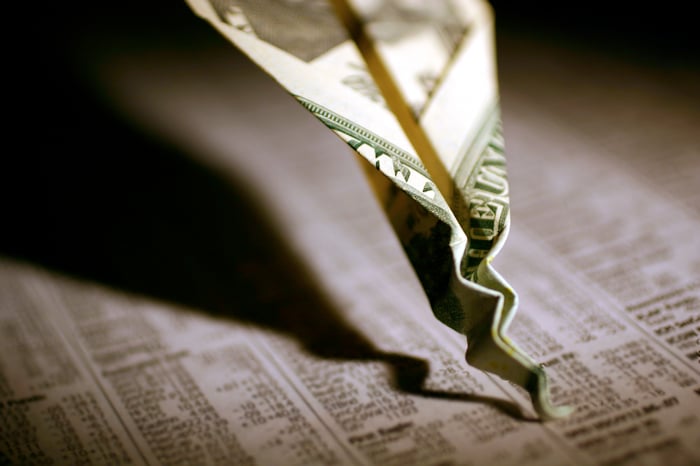Last year proved to be one of the most challenging on record for investors. When we officially turned the page, the ageless Dow Jones Industrial Average (^DJI 0.69%), widely followed S&P 500 (^GSPC 1.20%), and tech-dependent Nasdaq Composite (^IXIC 1.59%) respectively fell by 9%, 19%, and 33%. All three indexes spent at least some of 2022 entrenched in a bear market.
However, a new year brings new hope that brighter days are ahead for Wall Street. Unfortunately, history and hope are at odds with each other.

Image source: Getty Images.
Most stock market corrections are resolved in less than a year
While you might not realize it, stock market corrections -- declines of at least 10% from a recent high -- are fairly common. Since the beginning of 1950, the S&P 500 has undergone 39 separate corrections, according to data from sell-side consultancy firm Yardeni Research.
The vast majority of these declines don't take long to find their respective bottoms. Not including the 2022 bear market, 24 of the previous 38 corrections since 1950 reached their troughs in 104 or fewer calendar days (about 3 1/2 months). Another seven corrections took between 157 calendar days and 288 calendar days to resolve. In other words, in all but seven corrections in a 73-year time span, a stock market decline has taken longer than 10 months to reach its bottom.
As of the closing bell on Jan. 4, 2023, the S&P 500 had spent 282 calendar days in a bear market, per Yardeni. We're just a few days away from entering rarified territory when it comes to the length of the existing decline.
If there is a positive here, it's that the length of a stock market correction doesn't correlate with the magnitude of decline. Four of the 10 longest corrections in the S&P 500 since 1950 resulted in peak declines ranging from just 14% to 19%.
Nevertheless, the existing bear market doesn't look to be anywhere near a bottom.
This may become the longest bear market on record
There's no question that the Federal Reserve and investors (both tenured and new) are navigating unchartered waters. At no point in the history of our nation's central bank has it had to aggressively raise interest rates while the stock market plunges. But with the U.S. inflation rate spiking to a four-decade high of 9.1% in June, taming the pace of price hikes became paramount.
Although Federal Reserve monetary policy isn't particularly useful in identifying when a stock market correction will occur or how steep the decline will be, it can be quite useful in deciphering when the stock market will find a bottom and reverse course.

Effective Federal Funds Rate data by YCharts.
Since this century began, the Fed has undertaken three interest rate easing cycles (i.e., the nation's central bank lowered interest rates). In each of these instances, it took the benchmark S&P 500 a long time to find its footing.
- Jan. 3, 2001: During the dot-com bubble, the nation's central bank reduced the federal funds rate from 6.5% to 1.75% in less than a year. However, it took 645 calendar days after this initial rate cut for the S&P 500 to reach its nadir.
- Sept. 18, 2007: The financial crisis coerced the Fed to slash its federal funds rate from 5.25% to a range of 0% to 0.25%. But the S&P 500 didn't find its bottom until 538 calendar days after this first rate cut.
- July 31, 2019: The third easing cycle this century saw the Fed lower its fed funds rate from a range of 2% to 2.25% to 0% to 0.25%. The S&P 500 hit its bottom during the coronavirus crash in March 2020 -- 236 calendar days after this first rate cut.
On average, it's taken 473 calendar days (about 15 1/2 months) this century for the broad-based S&P 500 to find its bottom after the central bank begins a rate-easing cycle.
Here's the problem: The Fed is nowhere near an easing cycle. According to the Fed's "Summary of Economic Projections" (also known as the "dot plot") in December 2022, interest rate easing isn't expected until sometime in 2024. If that's the case, and the S&P 500 adheres to this century's average timeline to find a bottom, we're talking about a bear market that could easily top more than 1,000 calendar days and become the longest on record. As of now, the longest bear market occurred between 2000 and 2002 and lasted 929 calendar days.

Image source: Getty Images.
Three smart ways to invest during lengthy bear markets
While this probably isn't the projection you want to hear, it doesn't have to be terrible news, either. Bear markets have, historically, been an excellent time to put money to work and have allowed investors to buy into time-tested businesses at significant discounts.
One of the smartest moves investors can make during a lengthy bear market is to buy dividend stocks. Publicly traded companies that pay a dividend are usually profitable on a recurring basis and have successfully navigated their way through previous economic downturns. What's more, dividend stocks have outperformed non-payers by a significant amount over long periods. In short, they're just the type of businesses you should want to own when uncertainty is prevalent.
Investing in defensive sectors and industries can be a genius move, too. For example, electric utilities are a solid bet to outperform during a bear market due to their highly predictable cash flow. Homeowners and renters don't change their electricity consumption habits much from year to year. Furthermore, most electric utilities operate as monopolies or duopolies, which leaves little choice for consumers.
A third smart move during lengthy bear markets is to consider buying exchange-traded funds (ETFs). Buying ETFs allows investors to instantly diversify or concentrate their investments at the click of a button. With an ETF for pretty much every sector, industry, trend, region, and market cap, investors have an abundance of ways to put their money to work over the long run without necessarily having to worry about single stock risk.
The key point here is that continuing to invest, even during a potentially lengthy bear market, is a wise decision for long-term-minded investors.




